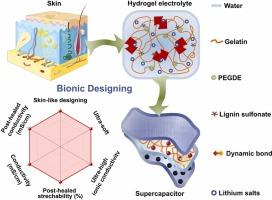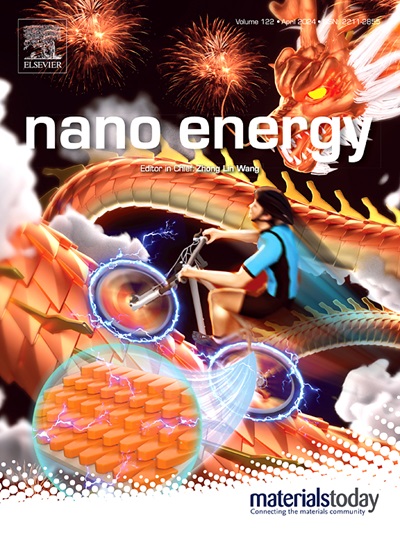Bioinspired extreme environment adaptive hydrogel enabled by weakening hydrogen bonding
IF 16.8
1区 材料科学
Q1 CHEMISTRY, PHYSICAL
引用次数: 0
Abstract
Most reported hydrogel electrolytes exhibit incompatible electrolyte-electrode interface, overhigh modulus, extreme environment inadaptation, high costs and toxic residual. Inspired by moisturizing and ductile properties from skin, this study presents a cost-effective, low-toxicity and self-healing hydrogel electrolyte composed of gelatin, lignin sulfonate and LiBr. The hydrogen bonds within hydrogel electrolyte were significantly weakened by LiBr, thereby exhibiting ultra-soft properties under the fracture stress of 8.5 kPa and strain of 1558 %, retaining an elongation of 1030 % after instantaneous self-healing, and remaining electrolyte-electrode interface stable. Additionally, abundant disordered hydrogen bonds and remarkable hydration capability of the hydrogel electrolyte endowed the ultra-high ionic conductivity (1.26 mS/cm at −50 °C) and adaptability under extreme environment. Notably, the assembled supercapacitor remains effectively electrochemical performance from severe dehydration to ambient environment. This work provides insights for design of flexible hydrogel electrolytes with excellent environmental adaption.

求助全文
约1分钟内获得全文
求助全文
来源期刊

Nano Energy
CHEMISTRY, PHYSICAL-NANOSCIENCE & NANOTECHNOLOGY
CiteScore
30.30
自引率
7.40%
发文量
1207
审稿时长
23 days
期刊介绍:
Nano Energy is a multidisciplinary, rapid-publication forum of original peer-reviewed contributions on the science and engineering of nanomaterials and nanodevices used in all forms of energy harvesting, conversion, storage, utilization and policy. Through its mixture of articles, reviews, communications, research news, and information on key developments, Nano Energy provides a comprehensive coverage of this exciting and dynamic field which joins nanoscience and nanotechnology with energy science. The journal is relevant to all those who are interested in nanomaterials solutions to the energy problem.
Nano Energy publishes original experimental and theoretical research on all aspects of energy-related research which utilizes nanomaterials and nanotechnology. Manuscripts of four types are considered: review articles which inform readers of the latest research and advances in energy science; rapid communications which feature exciting research breakthroughs in the field; full-length articles which report comprehensive research developments; and news and opinions which comment on topical issues or express views on the developments in related fields.
 求助内容:
求助内容: 应助结果提醒方式:
应助结果提醒方式:


